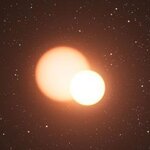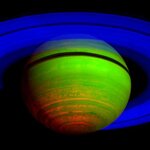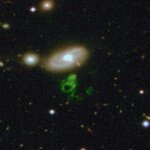Space

Classical Cepheid Variables, commonly called Cepheids, are unstable stars larger and much brighter than the Sun which expand and contract in a regular way, taking anything from a few days to months to complete the cycle and the time taken to brighten and grow fainter again is longer for stars that are more luminous and shorter for the dimmer ones.
This remarkably precise relationship makes the study of Cepheids one of the most effective ways to measure the distances to nearby galaxies and from there to map out the scale of the whole Universe.
Despite the extensive nature of their studies,…

The Nov 22 launch of the heaviest satellite known has everyone a twitter. A Delta IV Heavy booster out of Kennedy put up NROL-32, a "classified spy satellite cargo for the U.S. National Reconnaissance Office"."I believe the payload is the fifth in the series of what we call Mentor spacecraft, a.k.a. Advanced Orion, which gather signals intelligence from inclined geosynchronous orbits," Ted Molczan, an established satellite tracker told Spaceflight Now.
Some have called it the largest, but with a suspected 100 meter antenna, it's potentially smaller than earlier test NRO antennae…
Astronomers using two decades of observations from many telescopes around the world have discovered an unusual star system which looks like, and may even once have behaved like, a game of snooker. Or billiards, depending on which side of the pond you are on.
They looked at a binary star system called NN Serpentis, which is 1670 light years away from Earth. NN Serpentis is actually a binary star system consisting of two stars, a red dwarf and a white dwarf, which orbit each other in an incredibly close, tight orbit. By lucky chance Earth sits in the same plane as this binary star system…

Every wonder what to get an astronomy fan for a present? In this 365DOA Podcast, Emma the waitress and Sandy the diner roleplay the Meteorite Cafe. Judging by that name, you can guess what we suggest. Who can resist a rock older than the Earth? Even better, who can resist a rock from space that is older than the Earth and costs less than $20?
Technically, meteorites formed in space around the same time the Earth was forming. While Earth went through various atmospheres and engaged in active rock forming and plate techtonics, meteors just sat out in space,…

An exoplanet orbiting a star that entered our Milky Way from another galaxy has been detected by astronomers. This Jupiter-like planet is unusual because it is orbiting a star nearing the end of its life and could be about to be engulfed by it. Over the last 15 years, astronomers have detected nearly 500 planets orbiting stars in our cosmic neighborhood, but none outside our Milky Way has been confirmed. The planet has a minimum mass 1.25 times that of Jupiter and is part of the so-called Helmi stream — a group of stars that originally belonged to a dwarf galaxy that was devoured…

This story about the "chubby" galaxy cluster Abell 1689 and dark matter made me laugh out loud. Here's the title:
Chubby Galaxy Cluster Suggests Dark Energy Was Stronger Long Ago
Then, later on in the story:
The new dark matter map reveals that Abell 1689 is denser at its center than physical models would predict.
"Abell 1689 appears to have been well fed at birth from the high density of dark matter surrounding it," Coe told SPACE.com. "This has given it a chubby belly which it has carried through its adult life to appear as we observe it today."
Awesome. So it isn't just Big Macs and beer…

Saturn emitted less energy each year from 2005 to 2009, according to observations by NASA's Cassini spacecraft, but Saturn's southern hemisphere consistently emitted more energy than its northern one and those energy levels changed with the seasons.
That Saturn actually emits more than twice the energy it absorbs from the sun has been a science puzzle for decades but long-term data from the composite infrared spectrometer (CIRS), when combined with information about the energy coming to Saturn from the sun, could help scientists understand the nature of Saturn's internal heat source. …

I finished building my test Picosatellite! It's a working skeleton, using the real PCB boards but without the electronics wired in. In short, it's 'real enough'. Were I to put in half of the $264 worth of electronics I bought at DigiKey, and toss in a BasicX chip and the 2 radio parts, it would be flyable.
But I shall not fly it. I can do better. In fact, I will do better. This first build is intended to be my flight test rig. This one, it's what I'll beat on, solder poorly, and break. It may catch fire, if I screw upl so be it. Rather…

The Herschel Space Observatory is the largest telescope in space. It's capable of detecting longer-wavelength light than the human eye can, light in the far-infrared portion of the electromagnetic spectrum, which is the type emitted by galaxies lined up behind other ones in the foreground.
The result is that scientists are discovering hundreds of new galaxies through brighter galaxies in front of them that deflect their faint light back to the massive Herschel telescope, an effect identified by Albert Einstein a century ago known as cosmic gravitational lensing.
When such a lineup…

In our many accolades of citizen science, nothing stands taller among discoveries than the strange object Hanny van Arkel found in archived images of the night sky in 2008.
After catching sight of it, courtesy of Hanny and Galaxy Zoo, astronomers were determined to learn more about Hanny's Voorwerp (Hanny's "object" in Dutch). Now they say they have discovered that Hanny's Voorwerp represents a 'snapshot in time' that reveals surprising clues about the life cycle of black holes.
In a new study, astronomers have confirmed that Hanny's Voorwerp is a large cloud of glowing gas…